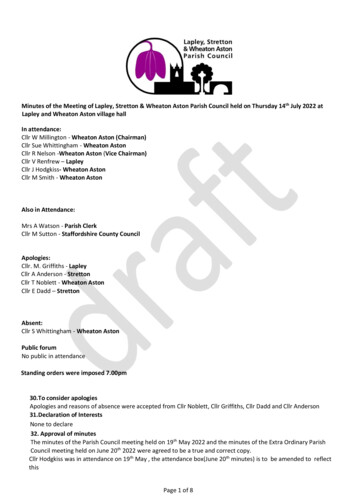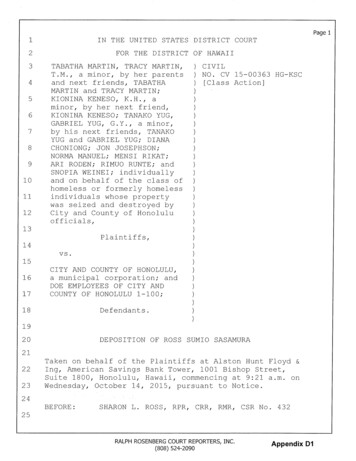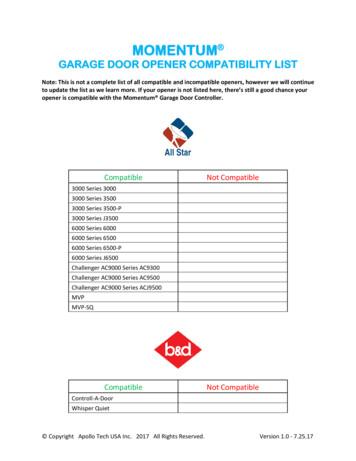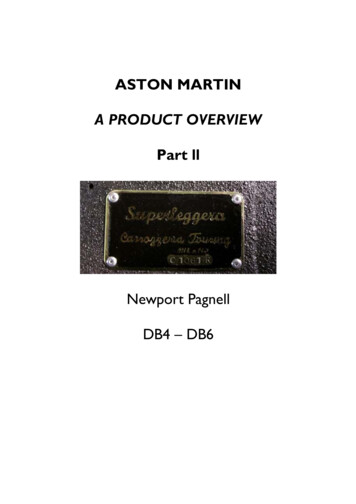
Transcription
ASTON MARTINA PRODUCT OVERVIEWPart llNewport PagnellDB4 – DB6
BibliographyWith thanks toAston Martin V8Michael BowlerCadogan PublishingAston Martin & LagondaPressDavid G StylesThe CrowwoodAston Martin Buyers GuideInternationalPaul R WoudenbergMotorbooksAston Martin V8sF Wilson McCombOsprey Auto HistoryAston Martin Gold PortfolioR M ClarkeBrooklands BooksAston Martin Road TestsAdrian FeatherThe Scolar PressAston MartinPublicationsDudley CoramMotor RacingAMOC RegistersAMOCThe Most Famous Carin the WorldDavid WorrallSolo PublishingAstonHeritageJournal of the AstonAston MartinMartin Heritage TrustTrustDavid DowseyPeleus PressPower, Beauty and Soulwww.astonmartin.com2
I have been working in the world of Aston Martin for the past 25 years. Icame upon the marque in my general course of business in the motor tradeand have become as enthusiastic as my customers about Aston Martin andtheir products.My son Matthew and I with my first Aston MartinThere is an aura about Aston Martin, a heritage far beyond simple statistics.Winning at Le Mans, victory in the World Sportscar Championship, theZagatos and Royal patronage would be enough for any car manufacturer.Aston Martin goes beyond that – every car has its character and everyowner, real pride in his or her car.Any market place has pitfalls for the unwary and opportunities for theunscrupulous. What I have tried to produce is an overview of Aston Martincars that can act as an introduction to the marque. It is my view, colouredby my experiences and the use of my library of Aston Martin books as areference. Most of the Aston Martin photos are from my own archive andI have been fortunate enough to enjoy handling each of these glorious cars.This may represent your first foray into the world of Aston Martin; it maysupplement your own knowledge. Whatever your point of reference, Ihope this overview adds to your enjoyment.Philip JonesByron International3
THE ASTON MARTIN DB4Production dates:Top Speed:Acceleration:Chassis numbers:Team car chassis no:LengthWidthHeightGround clearanceTrackWheelbaseTurning circleDry weightEngineCapacityCylinder boreCompression ratioPower outputCarburettorsChassisTransmissionFront suspensionRear suspensionSteeringBrakesOctober 1958 – June 1963140 mph0 – 60 in 9.0 seconds, 0 – 100 in 20 secondsDB4/101/R-DB4/995/R, DB4/1001/L-DB4/1215/L14 feet 8.375 inches (448 cm)5’ 6” (1.68 m)4 feet 3.5 inches (131 cm)7 inches (177 mm)Front54inches(1372mm)Rear53.5inches(1360mm)98 inches (2490mm)34 feet2878 pounds (1311 Kg)3.7 litre3,670 cc92mm (stroke 92mm)8.25:1240 bhp @ 5500 rpm2 x SU HD8Square section tube frame, aluminium body.David Brown 4 speedUnequal transverse wishbones with Armstrong shockAbsorbers with co-axial coil springs and anti roll barCoil springs parallel trailing links and Watts linkageLocating live axle with Armstrong double actingLever shock absorbersRack and pinionDunlop disc with Lockheed vacuum servo assistance11.5 inch disc front11.125 inch disc rear1960 Aston Martin DB4 Series lChassis DB4/209/R BYRON INTERNATIONAL4
When the single pale primrose DB4 was launched at the Paris Salon in October 1958, MarcelBlondeau, the French distributor for Aston Martin approached John Wyer on the stand withtears in his eyes “This is not a car, it is a folly, but I can sell as many as you can supply.” With atop speed of 140 mph, it was one of the fastest four seaters in the world and was on a par withthe best of Italian Grand Turismos. Not wholly surprising, given the decision to have thisdistillation of years of Feltham ideas designed by Touring of Milan using their “Superleggera”system . The body consisted entirely of aluminium mounted on a trellis of small diameter steeltubes welded together. Body panels were attached to the trellis and clinched around angleplates which were welded to the members with graphite pads.1965 DB5 showing “Superleggerra” FrameworkChassis No: DB5/1993/R BYRON INTERNATIONALItems like windscreen, rear window frames an angle sections for the door hinges were attacheddirectly to the frame. The design delivered slim proportions and outstanding all-round visibility.With the body mounted on a platform chassis, the seats could be set low without resorting todeep sills. The doors, which undercut the windscreen, were wide with frameless windows – noquarter lights – and the rear windows opened hingeing on their forward edges. Easier access tothe rear with its new full width rear seat, past hinged and adjustable front seats from Reutter.The wide parcel shelf concealed the presence of a 19 gallon petrol tank while at the back of thecar, the boot lid opened to floor level. The battery, with its own master switch was behind apanel in the right hand wing and the spare wheel was in a separate contained under the bootfloor. Power came from the all new Tadek Marek twin overhead cam aluminium engine thatweighed in 22Kg less than its predecessor. The twin cam shafts operated the valves directlythrough inverted steel tappets while those valves were splayed at an 80 degree angle – the seatsall had inserts and the exhaust guides were all in direct contact with cooling water. The blockfollowed the contour of the liners which combined to save weight and strengthen the structure.The crankshaft was a nitirided steel forging which ran in seven bronze bearings – the connectingrods were polished and weight graded while the pistons each had two compression rings, thetop one being chrome faced. Driving through a four speed, all synchromesh gearbox and a 10inch single, dry plate Borg and Beck clutch – the engine was quoted as developing 240 bhp,although this was, in truth, probably nearer 208 bhp. Marek had, at John Wyer’s suggestion,researched horsepower claims on American engines and had found a mean discrepancy of 32per cent – John Wyer’s reaction was “We can’t lie that much, we can only lie 15 per cent”.Ride and handling came courtesy of Harold Beach designed coil and wishbone front suspensionand a rear set up of trailing arm and coil spring incorporating a Watts linkage. The brakes wereall wound discs from Dunlop with a Lockheed servo fitted. Wire wheels with Dunlop centrelocks and 16 inch Avon Turbospeed tyres as standard fitment. At launch, Aston Martin only hadtwo pre-production models and with one used to promote the new car, they were reluctant toentrust the other, untried and untested model to the motoring press so definitive road testswere not available, just the enthusiastic hyperbole of John Wyer. His claim, made before launch,that the car could go from a standing start to 100 mph and back to standstill in 30 seconds wasfaithfully reproduced in advertising material. It was on October 2nd, the day of the car’s launchin Paris that tests at MIRA proved him correct with mean times set of the feat at 27.2 seconds.Sadly industrial disputes meant that full production did not get under way until 1959.5
Driving along the highway on the way back to San Francisco on a trip to buy a DB4GT Zagato(DB4GT/0188/L) , I took a call from someone offering me DB4 with a Chevrolet engine. Theonly positive was its alleged first owner, Robert Mitchum but, whether it was the sunshine orthe Pacific breeze, without having seen the car, I agreed to buy it. Glad to say that theprovenance was good and, even better, the car is now back in pristine condition.1962 Aston Martin DB4 Mkll VantageChassis No: DB4/489/L BYRON INTERNATIONAL6
1960 Aston Martin DB4Chassis No: DB4/235/R BYRON INTERNATIONAL7
THE ASTON MARTIN DB4 – A Development StoryThe DetailSeries l:Launch – February 1960: Instrument panel inherited from the DB2/4 Mark lll . No chromesurrounds were fitted to the windows on the initial production (50 cars) and after that initialrun, over riders and heavy duty bumpers were fitted.Series llJanuary 1960 – April 1961: Heavy duty front callipers were fitted together with a 17 pint sumpand a radiator blind and the bonnet hinged from the front. The height of the car was increasedby half an inch to 4 feet 4 inches while the car was lowered with the ground clearance movingfrom 18 cm to 16 cm. Various options were introduced including an oil cooler, selected by 34buyers, electric windows and an overdrive unit. The overdrive was normally used with a 3.77rear axle – discounting these options, the kerb weight of the car increased by 45Kg to 1,353Kg.Series lllApril 1961 – September 1961: Optional oil cooler continued from Series ll, selected by 53Series lll buyers. An additional bonnet sty fitted together with a modified handbrake, clutchcover and brake pedal linkages. Separate rear lights fitted on a chrome plate, a single stalkswitch, courtesy switches and an electric tachometer. The heating system was improved withthe fitment of 5 rather than 3 demister outlets and an optional 4.09 ratio rear axle wasoffered. Three cars in this series were sold with the special fitment of a DB4GT engine.Series lVSeptember 1961 – October 1962: Lower bonnet scoop introduced as well as a new grille with7 vertical bars and internally, the ashtray was moved from the top of the dash to the gearboxcover. Also introduced as an option was a Vantage or Special Series (/SS) engine. With 3 SUHD8 carburettors, larger valves and a 9:1 compression ratio, this engine delivered 266bhp at5,750 rpm. Most cars fitted with this engine were also given a restyled front sloping headlampsand called the DB 4 Vantage. Internally, the GT instrument panel with separate gauges wasfitted to most carsSeries VSeptember 1962 – June 1963: The body was extended by 9cm to provide more leg room andboot space. A higher roof gives the best indicator of change in the line where the roof meetsthe boot lid, but the overall height of the car remained the same 132cm because of the changeto 15 inch wheels. Under the bonnet, an airbox on the carburettors, an electric fan in front ofthe radiator and a vacuum advance. Smaller brake pads complete the external differences.DB4 ConvertiblesIntroduced at the London Motor Show in 1961: Of 1,110 Aston Martin DB 4’s manufactured,only 70 were convertibles. The first 30 were Series lV cars (11 with Vantage engines) and thebalancing 40 cars were Series V of which 21 were built with Vantage engines. The standardpetrol tank was replaced by twin tanks positioned in the rear wings with a combined capacity of16 gallons – 3 gallons less than the coupe.8
1959 Aston Martin DB4 Mark IChassis DB4/109/R BYRON INTERNATIONAL1960 Aston Martin DB4 Series llChassis DB4/372/R BYRON INTERNATIONAL1961 Aston MartinDB4 Series lllChassis DB4/649/R BYRON INTERNATIONAL1962 Aston Martin DB4 Series lVChassis DB4/834/R1962 Aston Martin DB4Series IV VantageChassis DB4/982/R BYRON INTERNATIONAL BYRON INTERNATIONAL1963 DB4 Aston Martin Series V VantageChassis DB4/1147/R BYRON INTERNATIONAL9
When the Aston Martin DB4 was conceived, there were no motorways in the United Kingdomand, as a result, no long term high speed testing had been conducted during development.Production of the car ramped up and exports, especially to France with the energetic MarcelBlondeau promoting the car he had fallen in love with at the Paris Show, put the car into newterritory. Arrow straight Routes Nationales – especially the 193 kilometers from Paris to LeMans where enthusiasts tried to set outright, if unofficial, records for the trip – proved toomuch, in high temperatures, for the all aluminium engine. The Italian market delivered the sameverdict with the new Autostrada del Sole between Milan and Bologna proving as tough a test forthe DB4.The problem was simple – as the engine temperature rose, bearing clearances grew to a pointwhere the oil pump could no longer cope. Flat out, it circulated oil at a rate of 20 gallons perminute and this was equivalent of the sump being changed once every eight seconds – at thepoint where the bearing clearances grew to great, the pump would be waiting for oil to get backand would suck air as well as oil with disastrous consequences. Tadek Marek delivered atwofold solution – the introduction of an oil cooler and adjustments to reduce the bearingclearances. At the same time, Aston Martin instituted a test programme utilising the newlyopened M1 motorway. Paradoxically, while the engines overheated, other customer complaintsrelated to poor heating and ventilation on the passenger compartment which was cured in theSeries lll in 1961 with five vents replacing the original 3.Changes in the car saw the kerb weight of the car rise and to help negate this, lighter bodyworkwas introduced – with half hard aluminium replaced by two sets of lighter panels in 1.26 and 2per cent aluminium magnesium. At the same time passenger experience was improved withnew sound deadening materials and a replacement silencer. With Aston Martin almostreluctantly marching towards the World Sports Car Championship, the development of engineperformance continued alongside the bodywork. Introducing 3 SU HD8 carburettors, putting inlarger valves and increasing the compression ratio from 8.2:1 to 9:1 delivered a stated 266 bhpat 5,750 rpm. An oil cooler was fitted as standard, a new throttle linkage fitted and the Vantagename, last used in the Aston Martin DB2, was revived. The car was instantly recognisable withthe headlamps recessed and protected with perspex covers to improve aerodynamics.Astonishingly, at 4,230, the Vantage version of the DB4 was only 145 more expensive thanthe standard coupe.The ultimate DB4, the Series V, was introduced in September 1962 – a longer and taller bodygave more leg, head and luggage room. Putting the car on 15 inch rather than the original 16inch wheels, meant that, even with the higher profile, the overall height of the car wasunchanged. A thermostatically controlled fan kept the noise down and, after the first 50 carswere produced with the standard engine, the majority of the remaining production were fittedwith the Vantage engine and the distinctive headlamps. It is interesting that the “Aston MartinDB5” that James Bond drove in Goldfinger, was in fact a DB4 Mark V Vantage!.When production ended in June 1963, Aston Martin had built 1,100 DB4’s making it the mostnumerically successful Aston Martin ever built even exceeding the DB2 whose production ranfor 9 years. It set a benchmark for Grand Tourers but also set a foundation for performanceand specialist models that had a legacy that continued for decades.10
1961 Aston Martin DB4 Series lllChassis No: DB4/723/R BYRON INTERNATIONAL1962 Aston Martin DB4 Mark lV ConvertibleChassis No: DB4C/1061/R BYRON INTERNATIONAL1962 Aston Martin DB4 Series lVChassis DB4/834/R BYRON INTERNATIONAL11
THE ASTON MARTIN DB4GTProduction dates:Top Speed:Acceleration:Chassis numbers:Team car chassis no:LengthWidthHeightGround clearanceTrackWheelbaseTurning circleDry weightEngineCapacityCylinder boreCompression ratioPower outputCarburettorsChassisTransmissionFront suspensionRear suspensionSteeringBrakesOctober 1959 – June 1963152.5 mph0 – 60 in 6.4 seconds, 0 – 100 in 14.2 secondsDB4GT/0101/L–DB4GT/0201/L (except 0192 & 0194-8)DP199/114 feet 3.375 inches (435.3 cm)5’ 6” (1.68 m)4 feet 3.5 inches (131 cm)Front 54inches(1372mm)Rear 53.5inches(1360mm)93 inches (2362mm)34 feet2798 pounds (1269 Kg)3.7 litre3,670 cc92mm (stroke 92mm)9:1302 bhp @ 6000 rpm3 twin choke 45 DC0E4Square section tube frame, aluminium body.David Brown 4 speedUnequal transverse wishbones with Armstrong shockAbsorbers with co-axial coil springs and anti roll barCoil springs parallel trailing links and Watts linkageLocating live axle with Armstrong double actingLever shock absorbersRack and pinionGirling disc with Lockheed vacuum servo assistanceSwept area of 527 square inches1961 Aston Martin DB4GTChassis No: DB4GT/0147/R BYRON INTERNATIONAL12
A year after the arrival of the DB4, Aston Martin announced the DB4GT at the London MotorShow in 1959. Outwardly very similar in looks, the differences were substantial – the wheelbaseand body were shorter with the rear seat being replaced with a simple parcel shelf and using 18gauge magnesium aluminium for the body panels mean the car weighed in 85 kilograms lighterthan its big brother. The sporting pedigree was reinforced with lightweight centre-lock Borraniwire wheels made more distinctive with three rather than two knock-off spinners. The engineshared the same bore and stroke as the standard 3.7 but the head and block were lighter beingmade of RR50 alloy – twin spark plugs per cylinder were ignited by two distributors driven atright angles from the rear of the camshafts. Out went the standard twin SU carburettors to bereplaced by three Weber DCO E4 twin choke units. The twin camshafts were special high liftunits and the compression ratio for the engine was up to 9.0:1. The extra power demanded a 9inch twin rather than 10 inch single plate clutch, while the David Brown 4 speed gearbox wasclose ratio all synchromesh unit and a Salisbury Powr-Lock limited slip differential was standard.For stopping power, in place of the Dunlop discs on the standard DB4, large diameter Girlingunits derived from competition were used with no servo unit fitted. The 30 gallon light alloyfuel tank took most of the space in the boot but the interior of the car was trimmed andfinished to Aston Martin’s normal exacting standards. In similarly cavalier fashion to the headlinegrabbing headlines at the DB4 launch, the DB4GT was claimed to achieve 0-100 mph and backto standstill in 20 seconds. This was achieved, just, at MIRA with a driver and observer onboard. Over the winter of 1958/9, Aston Martin had worked to make the DBR1 race car asreliable as possible for a tilt at Le Mans – they had determined that all their efforts would befocussed on that one race.However, Stirling Moss asked to use the spare car for the Nurburgring 1000 and the factoryagreed, paying for transport, team manager Reg Parnell and a couple of mechanics. Paying hisown expenses, Moss went on to win the race. At Le Mans the Aston Martins scored amemorable first and second it left the team that had intended to only enter one race in aposition to win the World Championship which it went on to do with a win at the TouristTrophy at Goodwood. At the victory dinner in London, David Brown announced thecompany’s withdrawal from sports car racing to focus on production cars.With this withdrawal, the factory gave works support to John Ogiers newly established EssexRacing Stable who took the first three of five lightweight DB4GT’s built and campaigned themwith Roy Salvadori and Innes Ireland, who I later had the privilege to meet. They were enteredinto the 1960 Tourist Trophy and finished second and third behind Stirling Moss in a Ferrari.Moss himself competed three times in the DB4GT winning twice, once in Nassau in theBahamas and once at the Easter meeting at Goodwood.Also racing at this time was Jackie Stewart and I handled one of his cars – DB4GT/0147/R –shown opposite when I rescued it from many years of storage in a barn in Cornwall. InOctober, Essex Racing entered two cars into the Montlhery 1000 kilometre race against a hugenumber of Ferrari GTO’s. In spite of the urging of the enthusiastic Marcel Blondeau, AstonMartin’s French distributor, the best they could muster was sixth behind five Ferraris. After aseason of mixed fortunes, the DB4GT continued to be raced but more often in second stringraces as it had been overshadowed by the new, more potent, lighter and, arguably, prettierZagato version that was launched at the 1960 London Motor Show.13
1960 Aston Martin DB4GTChassis No: DB4GT/0136/R BYRON INTERNATIONAL14
Aston Martin constantly developed special models and various owners have donelikewise. One of the biggest influences on those owners has been Aston Martin’sassociation with Zagato. Here are a couple of examples:1961 Aston Martin DB4/685/Rin the style of a Zagato Race CarChassis No: DB4/685/R1960 Aston Martin DB4in the style of aDB4GT ZagatoChassis No: DB4/353/R15
THE ASTON MARTIN DB4GT ZagatoProduction dates:Top Speed:Acceleration:Chassis numbers:Team car chassis no:LengthWidthHeightTrackWheelbaseTurning circleDry weightEngineCapacityCylinder boreCompression ratioPower outputCarburettorsChassisTransmissionFront suspensionRear suspensionSteeringBrakesOctober 1960Sanction ll – 22nd July 1991Sanction lll - 1992153.5 mph0 – 60 in 6.1 secs, 0 – 100 in 14.1 secsSanction ll: 0–60 in 5.5 secs, 0 – 100 in 12.2 secsDB4GT/0176/R – 0191/R,0193/R,0199/R,0200/RSanction ll: 0192, 0196-0198Sanction lll: DB4/344/R, DB4/424/R0182R/ 0183R13 feet 10.5 inches5’ 6” (1.68 m)4 feet 2 inchesFront 54inches(1372mm)Rear 53.5inches(1360mm)93 inches (2362mm)34 feet24.75 cwt3.7 litre3,670 ccSanction ll: 4,212 cc92mm (stroke 92mm)9.7:1Sanction ll: 9.82:1314 bhp @ 6000 rpmSanction ll: 352 bhp @ 6000 rpm3 twin choke 45 DC0E4Sanction ll: 3 Weber 50 DCO1/SPSquare section tube frame, aluminium body.David Brown 4 speedUnequal transverse wishbones with Armstrong shockAbsorbers with co-axial coil springs and anti roll barCoil springs parallel trailing links and Watts linkageLocating live axle with Armstrong double actingLever shock absorbersRack and pinionGirling disc with Lockheed vacuum servo assistanceSwept area of 527 square inches1960 Aston Martin DB4GT ZagatoChassis DB4GT/0188/R BYRON INTERNATIONAL16
In the late fifties before regulation and bureaucracy, commissioning the construction ofimaginative and sensuous cars was often concluded on a handshake. One of those handshakesoccurred at Earls Court in 1959 when Aston Martin was dominating sports car racing and a newGrand Tourer - the short wheelbase DB4GT was on the Aston Martin stand.Driven by the desire of David Brown to produce an alternative to the Ferrari Berlinetta, it wasthen that John Wyer of Aston Martin met Gianni Zagato, the youngest son of Ugo Zagato whofounded his business in 1919. His friendship with Fiat engineer Vittorio Jano led to the design ofspecial bodies. When Jano moved to Alfa Romeo, Zagato created a look that was to make himfamous - the Alfa Romeo sports and racing cars, but the arrival of World War 2 heralded theend of that period for Zagato. Fortunately, for Aston Martin lovers there was a second periodof Zagato from the mid forties to the late fifties designed by the eldest son Elio, who utilisedaerodynamics resulting from his experience as a racing driver. Unfortunately, Elio was involvedin a road accident so Gianni, the younger son, joined the company, modernised the operation,and asked a brilliant new star to join them - Ercole Spada - leading to a series of outstandingdesigns, which kept Zagato in the spotlight.Early in 1960, the first DB4GT chassis was delivered to the Zagato facilities on the outskirts ofMilan. Ercole Spada, only 23 years old, was assigned to Aston Martin, and he created theDB4GT Zagato, 350 pounds lighter than the standard DB4GT it also had striking linesaccentuated by tightly drawn elliptical surfaces, all highly reminiscent of the equally rare andhandsome Ferrari 250 GT Berlinetta by Pinin Farina.At the London Motor Show that year, the wickedly purposeful Silver Grey car that appearedwas numbered 0220/R and although 19 cars were built and recorded, the final ones nearly thedecades later , there is no record of where 0220/R went – nothing has been seen or heard sincethat show.This came about when Victor Gauntlett and Peter Livanos, then Joint Chairmen of Aston MartinLagonda, with the agreement of Zagato, decided to build four works approved DB4GT ZagatoCoupes using chassis 0192, 0196,0197 and 0198 prepared by Richard Williams. All four carswere launhed at Protech House, Cobham on 22nd July 1991. Outwardly identical to theoriginals, the four cars have unobtrusive changes that positively impact their performance andhandling. The largest of these differences is the fitment of a 4.2 litre engine producing 352 bhp –slightly extended inlet manifolds help the 3 Weber carburettors work more effectively andalternators replaced the original dynamos. Improved front suspension geometry has removedthe old bump steer of the original. The back axles are braced by tubes welded to the nose ofthe differential and Goodyear Eagle tyres replaced the original Avons these fitting on smaller andwider 15 x 6 Borrani wire wheels.In 1992, with Zagato having two spare bodyshells, Richard Williams approached Walter Hayes,then Chairman of Aston Martin with a proposal for two further “Sanction” cars. Approval wasgiven on the understanding that these cars should be identified as being built after the originalbuild series finished. This was done and two “Sanction lll” cars were built – DB4/344/R and DB4424/R. John Ogiers stable was once more the leading exponent with the Zagato on the track –two examples were acquired, 0182R and 0183R respectively registered 1 VEV and 2 VEV. Theycompeted at Le Mans alongside a privately entered French Zagato – sadly all failed to finish asdid the DBR1 driven by Roy Salvadori. 2VEV did win a GT race at Aintree while Salvadori in 1VEV came third in the Tourist Trophy at Goodwood with Essex Racing winning the team prize.17
Aston Martin DB4GTZagatoChassis No: DB4GT/0177/R BYRON INTERNATIONALPhotographed 198918
19
THE ASTON MARTIN DB5Production dates:Top Speed:Acceleration:Chassis numbers:Team car chassis no:LengthWidthHeightGround clearanceTrackWheelbaseTurning circleDry weightEngineCapacityCylinder boreCompression ratioPower outputCarburettorsChassisTransmissionFront suspensionRear suspensionSteeringBrakesOctober 1958 – June 1963140 mph0 – 60 in 7.1 seconds, 0 – 100 in 16.9 secondsDB5C/1251/R – DB5/2275/L (except 2021,209415 feet (4572 mm)5’ 6” (1.68 m)4 feet inches (1346 mm)6.3 inches (160 mm)Front54inches(1372mm)Rear 53.5inches(1360mm)98 inches (2490mm)34 feet3233 pounds (1466 Kg)4 litre3,995 cc96mm (stroke 92mm)8.8:1282 bhp @ 5500 rpm3 x SU HD8Square section tube frame, aluminium body.David Brown 4 speed with overdrive5 speed ZF after chassis /1340Unequal transverse wishbones with Armstrong shockAbsorbers with co-axial coil springs and anti roll barCoil springs parallel trailing links and Watts linkageLocating live axle with Armstrong double actingLever shock absorbersRack and pinionGirling disc with separate servo assistance11.5 inch disc front10.8 inch disc rear1965 Aston Martin DB5Chassis DB5/1821/R BYRON INTERNATIONAL20
The launch of the Aston Martin DB5 in 1963 was memorable for many reasons. Its arrivalcoincided with the departure of John Wyer. It bore the mark of the masters who continued towork on the car – Tadek Marek in the choice of the 4 litre engine giving usable power rightthrough the engine range and Harold Beach moving the company on from the David Brown fourspeed box with overdrive to the competent, if slightly noisy, ZF five speed. The 4 litre enginehad three SU carburettors that helped deliver the smooth torque curve – the valve covers andthe exhaust manifolds were stove enamelled and a small hydraulic damper at the front of theengine eliminated vertical shake. There was a larger air filter and later a Lucas alternator tocope with the increase in electrical gadgets.More power meant that the old single place clutch was replaced with a 9 inch Borg & Beckdiaphragm unit, significantly reducing the pedal pressure needed. 3 transmission alternatives canbe found on DB5’s – first fitment was a David Brown 4 speed box with a Laycock deNormanville overdrive. However, from chassis number 1340, a ZF 5 speed box was fitted. Theunit had seen life in commercial vehicles and with Maserati but importantly for Aston Martin, itcould cope with the torque of the new engine. A little noisy at idle, it also gave its share ofclutch problems and the Borg & Beck clutch gave way to a Laycock single diaphragm unit.Perhaps reflecting Aston Martin’s luxury image, the third transmission is the Borg-Warnerautomatic, which, although it had been fitted to the Lagonda, made its debut with Aston Martinon the DB5.Aston Martin also introduced the option of air conditioning.There was already production experience from its fitment to the Lagonda Rapide, and for 320extra, the Normalair system was offered on the DB5. Lack of space under the bonnet meantthat the only place for the receiver and the evaporator was behind the rear seat. Toaccommodate this, the petrol tank was replaced with two wing mounted tanks in the manner ofthe DB4 convertible – this had the effect of reducing the capacity from 19 to 16 gallons of fuel.In spite of the fact that the DB5 was a direct derivative of the DB4, it cost 4,175 – a 670premium over its predecessor. The price differential to the convertible was maintained with itbeing offered at 4,490. A total of 1,021 Aston Martin were built – 89 less than the number ofDB4’s but over a much reduced production run. Of those 1,021 cars, convertibles accountedfor just 123 cars so it was a very low volume car. Even lower volume was one that derivedfrom a personal request from David Brown when he had asked the factory to convert a DB5Coupe into an estate car – the requirements were a capacity to accommodate his polo kit and agrilled rear compartment for his dogs.Conceived as a one off, the conversion was completed by a few master craftsmen at NewportPagnell by modifying the rear seating, adding a roof section and a rear door. That would havebeen the end of it if regular pubic appearances in the car by David Brown had not produced anumber of enquiries from potential customers. Too complex and costly to tool up for at AstonMartin, the conversions were undertaken by coachbuilders, Harold Radford of London, whobuilt a total of 12 examples.With John Wyer’s departure. David Brown relinquished some of his duties and introduced twonew faces at the top – Jack Thompson as joint managing director and Steve Heggie as his deputy.Steve had a keen sense of the value of promotion and publicity, and was instrumental in AstonMartin becoming the car of choice for James Bond.21
1966 DB5 Sho
4 THE ASTON MARTIN DB4 Production dates: October 1958 - June 1963 Top Speed: 140 mph Acceleration: 0 - 60 in 9.0 seconds, 0 - 100 in 20 seconds Chassis numbers: DB4/101/R-DB4/995/R, DB4/1001/L-DB4/1215/L Team car chassis no: Length 14 feet 8.375 inches (448 cm) Width 5' 6" (1.68 m) Height 4 feet 3.5 inches (131 cm)
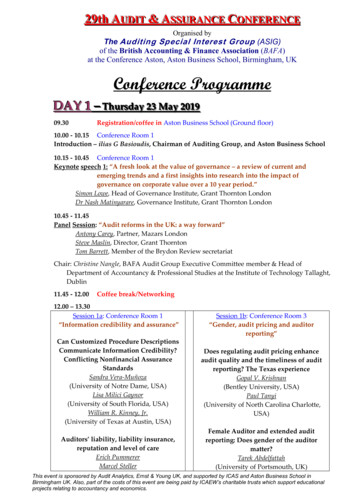

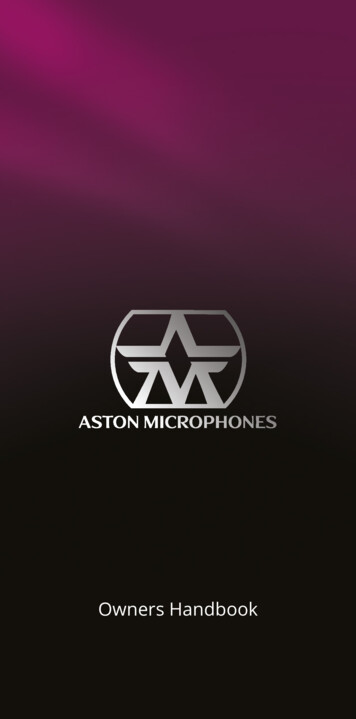
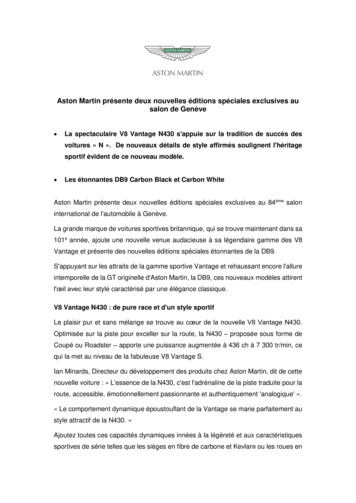
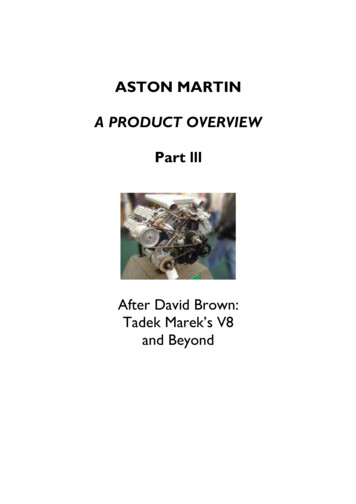

![Welcome [jobs.aston.ac.uk]](/img/37/college-20of-20health-20and-20life-20sciences.jpg)
